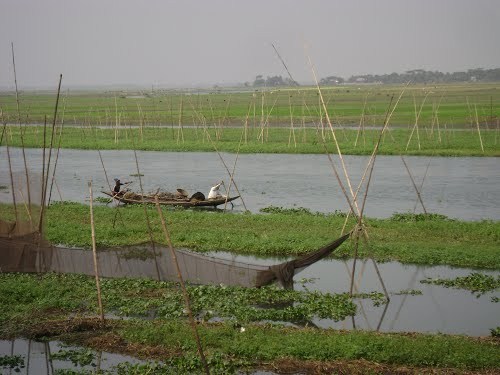May 9, 2019 – “Titash is a river’s name. Those living beside the river hardly know the etymological source of its name. They never tried to find out, they never felt any need to. There are rivers with significant names like Madhumati, Brahmaputra, Padma, Saraswati, Jamuna. And this one is called Titash!
No one will find its meaning in the dictionary. But is there any proof that the river might have been dearer to its people if it had a more literate, meaningful name? If a girl named Kajal-Lata is grandly renamed Baidurya Malini, her playmates will not be happy.”
“All the paths from the yards of Malo homes take them to the water of Titash. These are short paths. So short that a baby’s cry at one end can be heard by its mother at the other end. The pitter-patter of
~ Titash Ekti Nadir Naam, Adwaita Mallabarman, 1956
This slim Bengali novel based on the banks of River Titash, an offshoot of River Padma in Comilla, was to be iconoclastic in many ways. Published in 1956, Titash Ekti Nadir Naam was a Swan Song of not only its prodigious writer: Adwaita Mallabarman but the River and Malo fishing community on the banks of the Titash too.
Adwaita Mallabarman, born on the banks of the Titash in an impoverished Malo fisherfolk house, died in 1951 at the age of 37. He did not get to see his first novel published but his story of a river and its people
Till date, Titash has been showcased across the world. In many senses, Ghatak shared Mallabarman’s worldview and perhaps his onerous and solitary journey too. The movie and its spectacular vision, its cinematography and music is a subject for
Utpal Dutta, the renowned Bengali thespian, adapted Titash for
A story written in a lilting fisherfolk dialect of Bengali, about a small forgotten village has been speaking in many languages with many people across the world. That is the power of an honest, shining story of people and their
For the last few years, we’ve been trying to work on fisheries collapse in Indian subcontinent due to dams and drying rivers. A statistic we used (in the want of better statistics) is that about 10 million fisherfolk depend on our rivers for fish and they have nearly no mechanism to protect their livelihoods. Although mascots of flowing rivers, they are the weakest stakeholders in the powerful play around rivers and water.
Fisherfolk who have lived with a river for hundreds of years simply vanish when a dam comes up or when fish die, belly up, in a polluted river. Riverine fish species are declining so rapidly that several rivers have suffered a “Fisheries Collapse”. Today, Assam and West Bengal import frozen fish from fishponds in Andhra Pradesh.
But we forgot all about them. We could afford to forget all about them.
It is in this milieu that books like Titash Ekti Nadir Naam or Padma Nadir Majhi ( Boatmen of the Padma) or Kado Nodi Kado (Cry, River Cry) or Poddar Pollidip (Siltbar of the Padma) or
And these stories are not always dark. They are, after all, stories of the human spirit. Titash itself has exuberant passages about Magh Mandal Festival where tiny girls float decorated paper boats down the river or the sudden beauty of the riverine landscape which catches even the tough Malos unaware or the raw sensuality of adolescence or the many songs, phrases and lore which shine with a divine connection. At times, there is so much joie de vivre in the people of the book, that it puzzles us.
“Ananta gets down from his mother’s arms and stands on the ground, his eyes on the river. A little field mouse has come out of the maze of the paddy fields to finds itself suddenly beside the fairy-tale river brimming with liquid silver. Not a mere river- it is a thousand years of untold stories flowing on between the bounds of two banks.
Ananta is speechless. He bends over the boat’s edge to look into the crystal water. First, he sees his own small face. As he keeps gazing, he sees the sandy bed, shallow near the banks. He sees a silver tract left by a snail that moved along the sand and a group of small
In the words of Kalpana Bardhan, “What sustains wonder in lives that to others might seem deprived, closed and mundane? What sustains the artistic sensitivity and joy of living in the face of material poverty? Where does the human spirit spring from? The River’s fullness and
Adwaita writes:
“Who are the people who live beside Titash? They are Malo men and women. They are not those who live in brick houses with walls around, a pond in front, and a well on the side. They are not those with yards facing the roads that lead to the city and that cast out along the way, branches reaching towards towns and large villages, roads that carry horse-drawn vehicles.
All the paths from the yards of Malo homes take them to the water of Titash. These are short paths. So short that a baby’s cry at one end can be heard by its mother at the other end. The pitter-patter of
Bengal is a land of rivers, also known as Hazar Nodir Desh (land of thousand rivers) or Padma Par (Banks of Padma) or NadiMatrik Desh (Land mothered by rivers). It is but natural that this omnipresence will spill into the art of the region. From myths to legends, poetry to paintings, rivers are ever-present in the Bengali milieu.
In the words of Adwaita, “The bosom of Bengal is draped with rivers and their tributaries, twisted and intertwined like tangled locks, streaked with white foamy waves. The verdant land is like a maiden in the embrace of an ancient sage, held to his immense chest, locked in his wet kiss, his dense hair and beards tumbling in sinuous complexity over her youthful body and flowing on beyond. All these tangled gray locks are rivers.”
An estimated 71 “Riverine” novel written in Bengal
(former undivided Bengal) and Bangladesh . And yet, very few of these pieces of literature have come from the fishermen, boatmen or floodplain farmers themselves. Titash stood as the lonely exception in its day. Before Mallabarman published Titash Ekti Nadir Naam, a novel on fisherfolk of Padma: Padma Nadir Majhi was published in 1934. It was a touchstone of riverine writing. And yet, this diminutive son of a fisherman said that for all the great artistry, the author of Padma Nadir Majhi (Manik Bandyopadhyay) came from an educated Brahmin family and knew of the fisherfolk life from the margins. “It reflected “Brahmans’ son’s romantic view.” Many authors and critics, after 40-50 years, corroborated this view
Adwaita always spoke as a fisherman’s
In the din of the big city, he once lost the only manuscript of Titash that he wrote. But his few friends, many of whom came not from the literary circles, but from Comilla,
With failing health and little resources, Adwaita finished his book and was admitted in a hospital for Tuberculosis. He never recovered fully and died at the age of 37. Titash was published roughly 5 years after his death. Ironically, the book he was translating between bouts of TB was Lust for Life, Irving Stone’s biography on Vincent Van Gogh. Van Gogh was also 37 when he died.
Titash Ekti Nadir Naam brought us on the banks of the river, in the middle of the riverine people. We need hundreds of books like Titash today. After all, like E. L Doctorow said, “The historian will tell you what happened. The novelist will tell you what it felt like.”
~ Parineeta Dandekar, SANDRP, parineeta.dandekar@gmail.com
https://sandrp.in/2019/05/09/titash-ekti-nadir-naam-swan-song-of-a-river/





